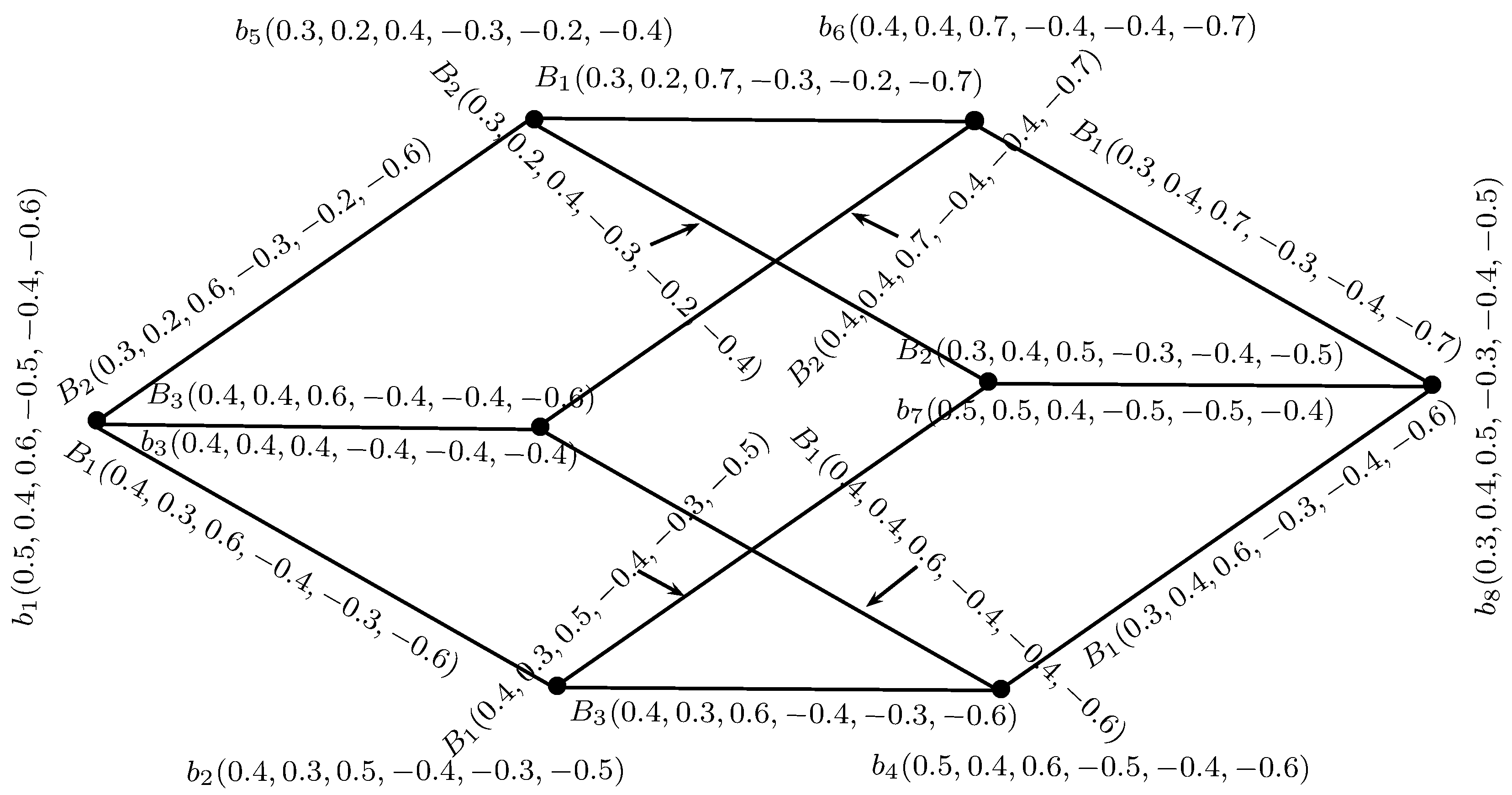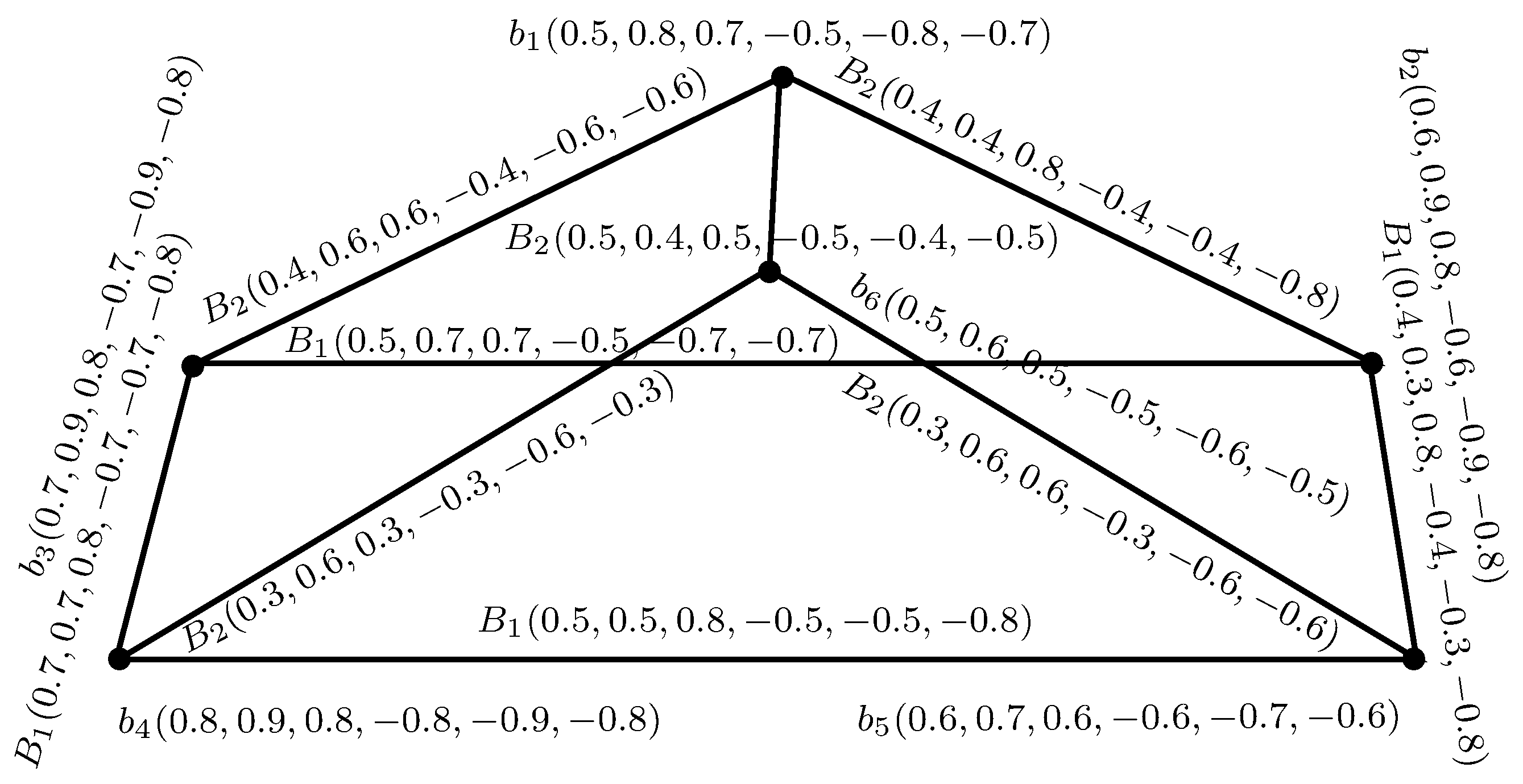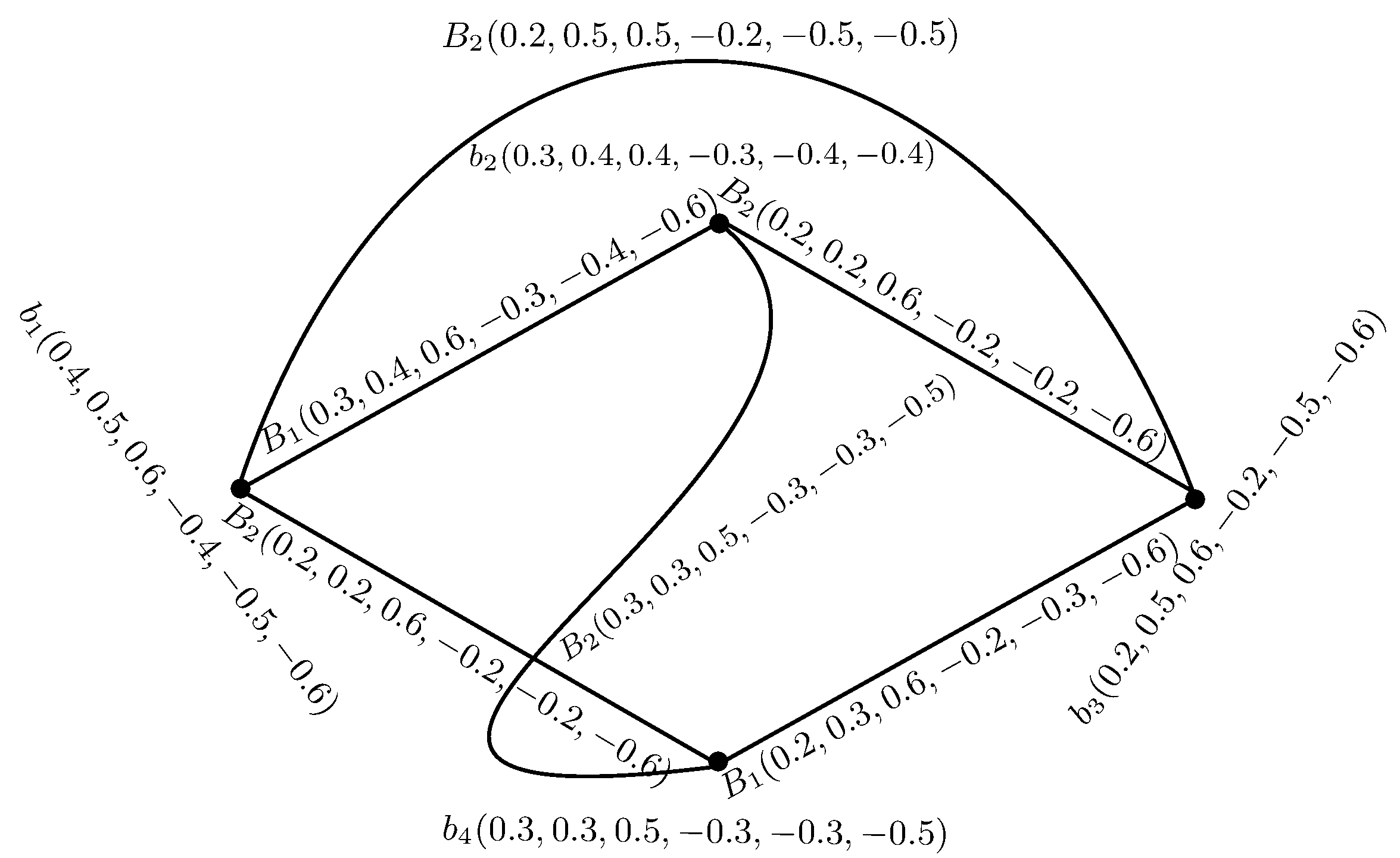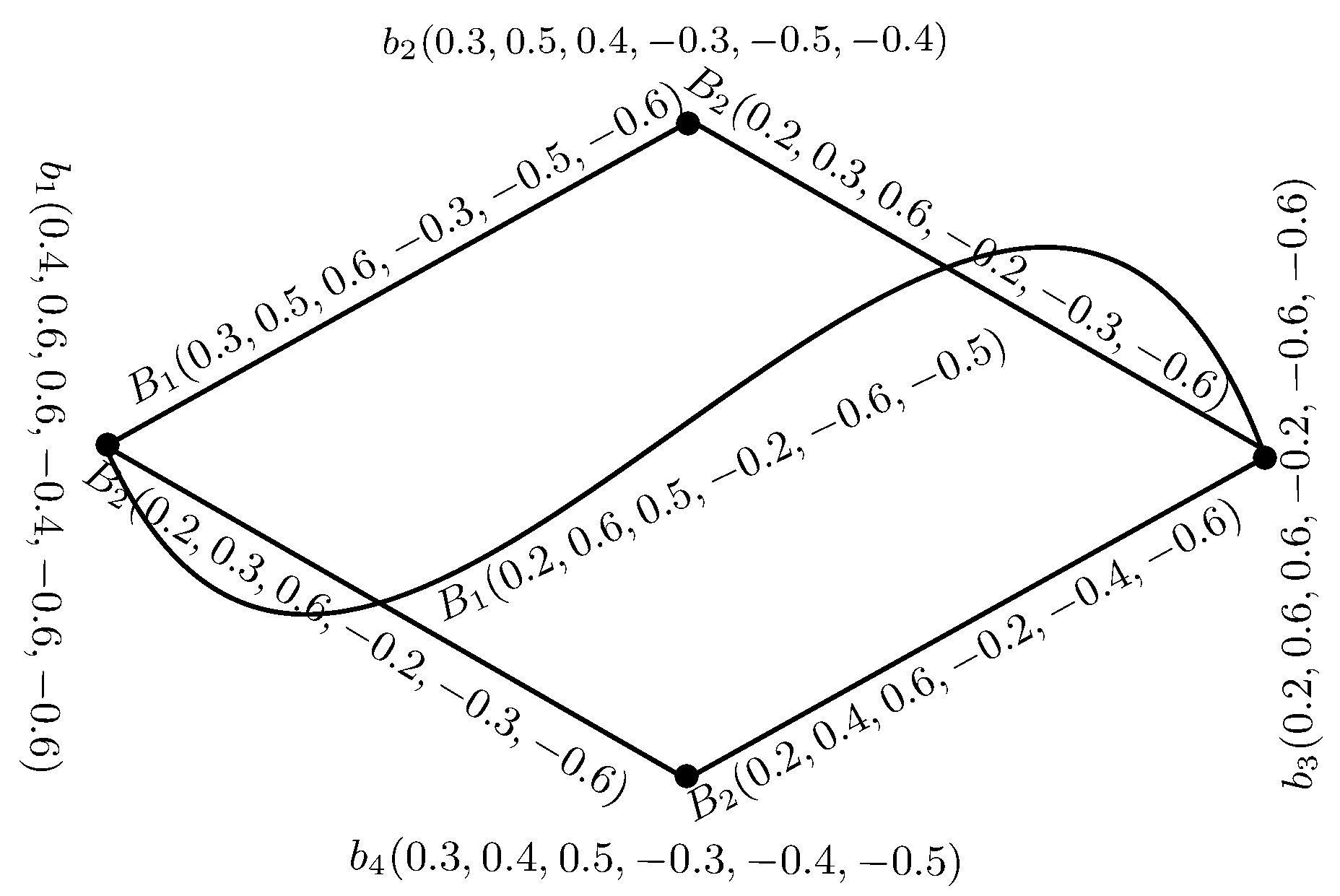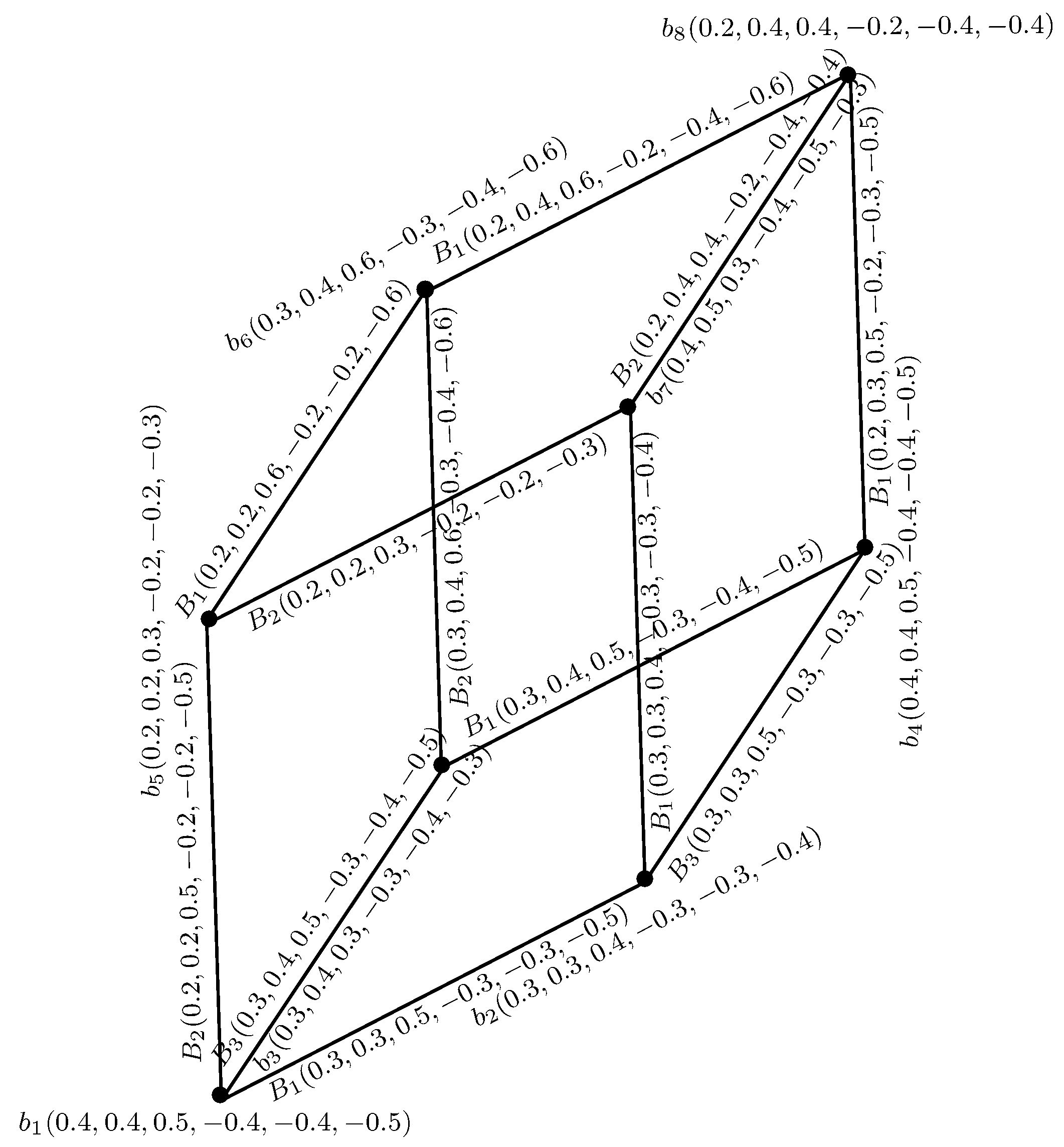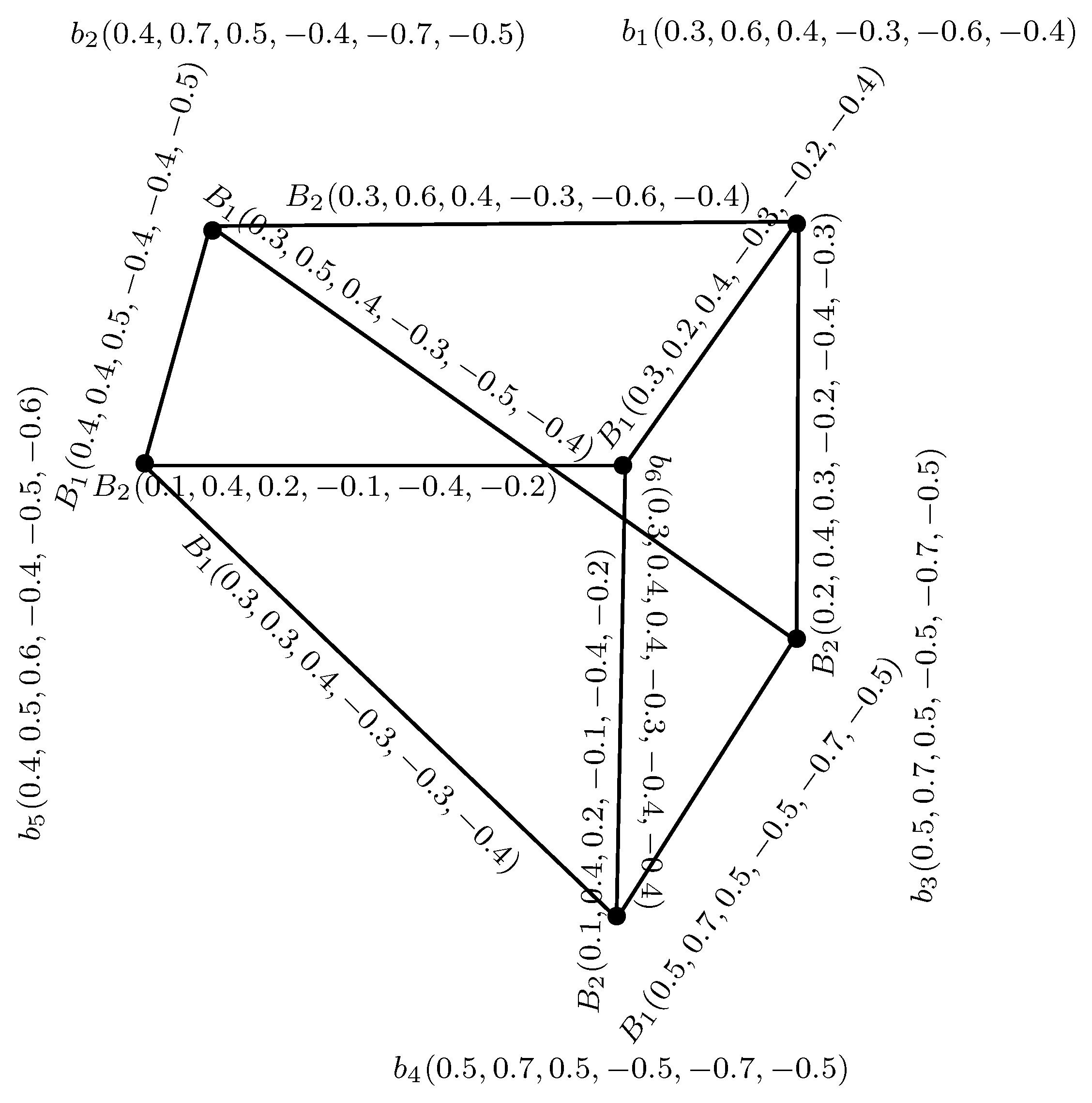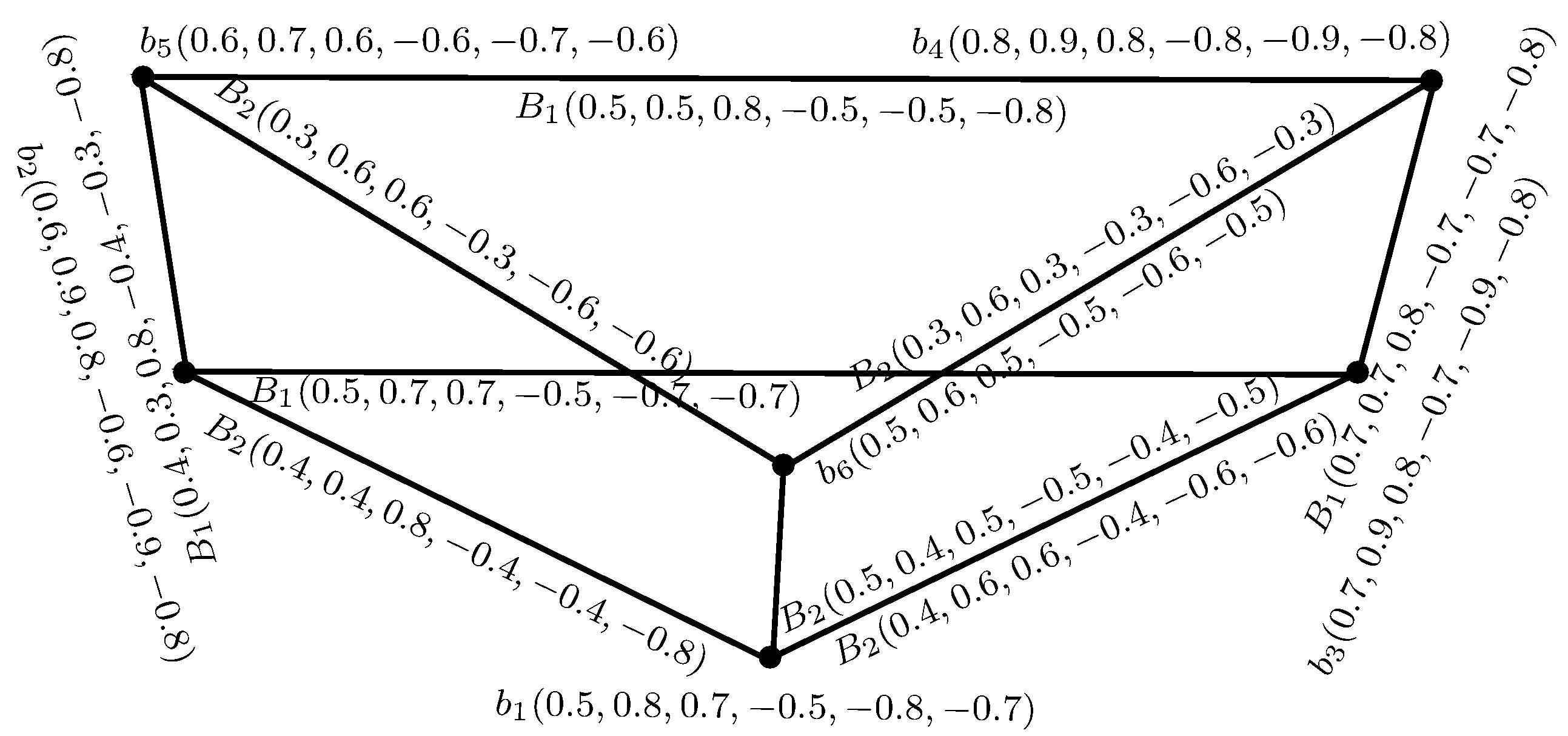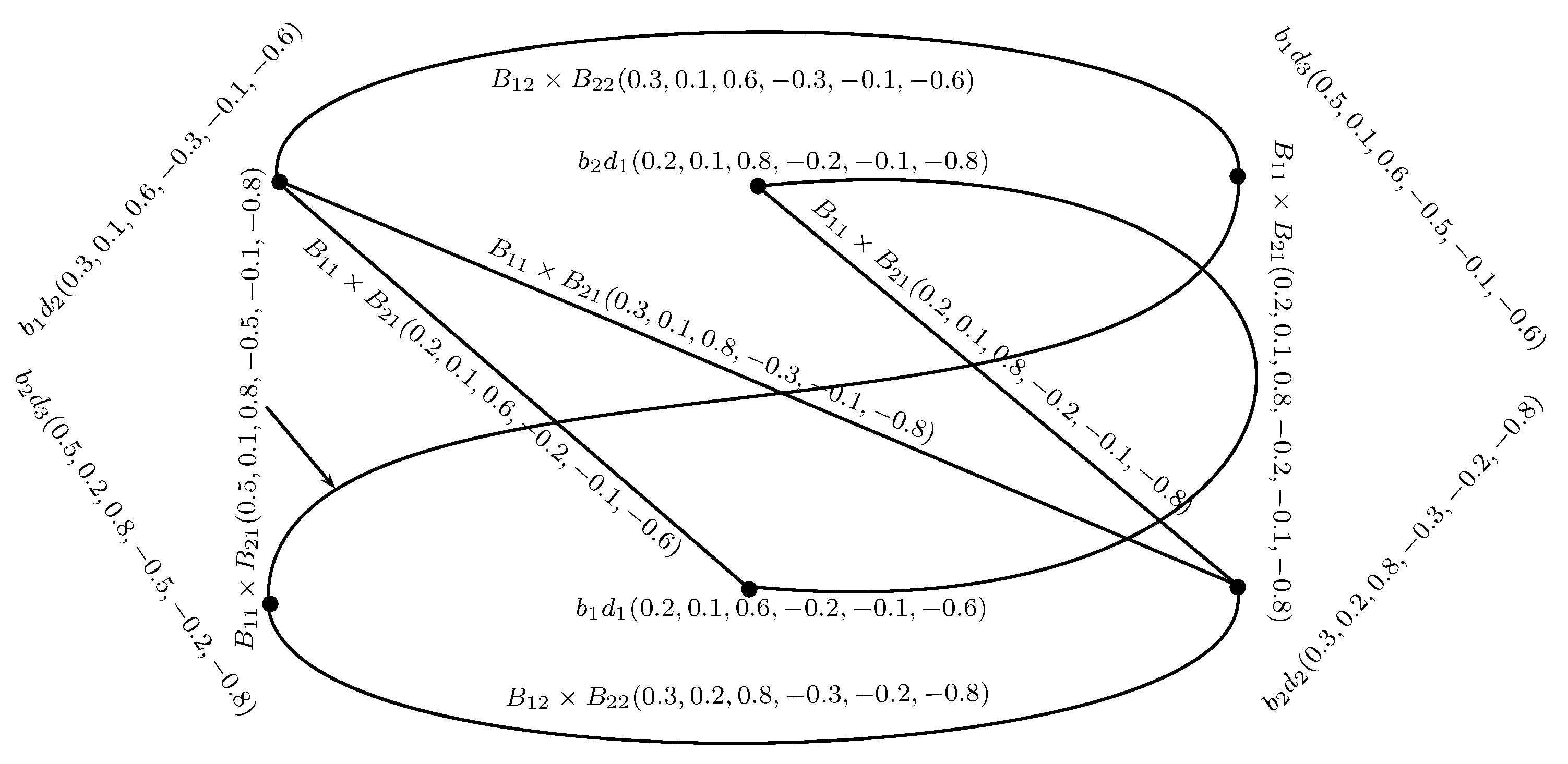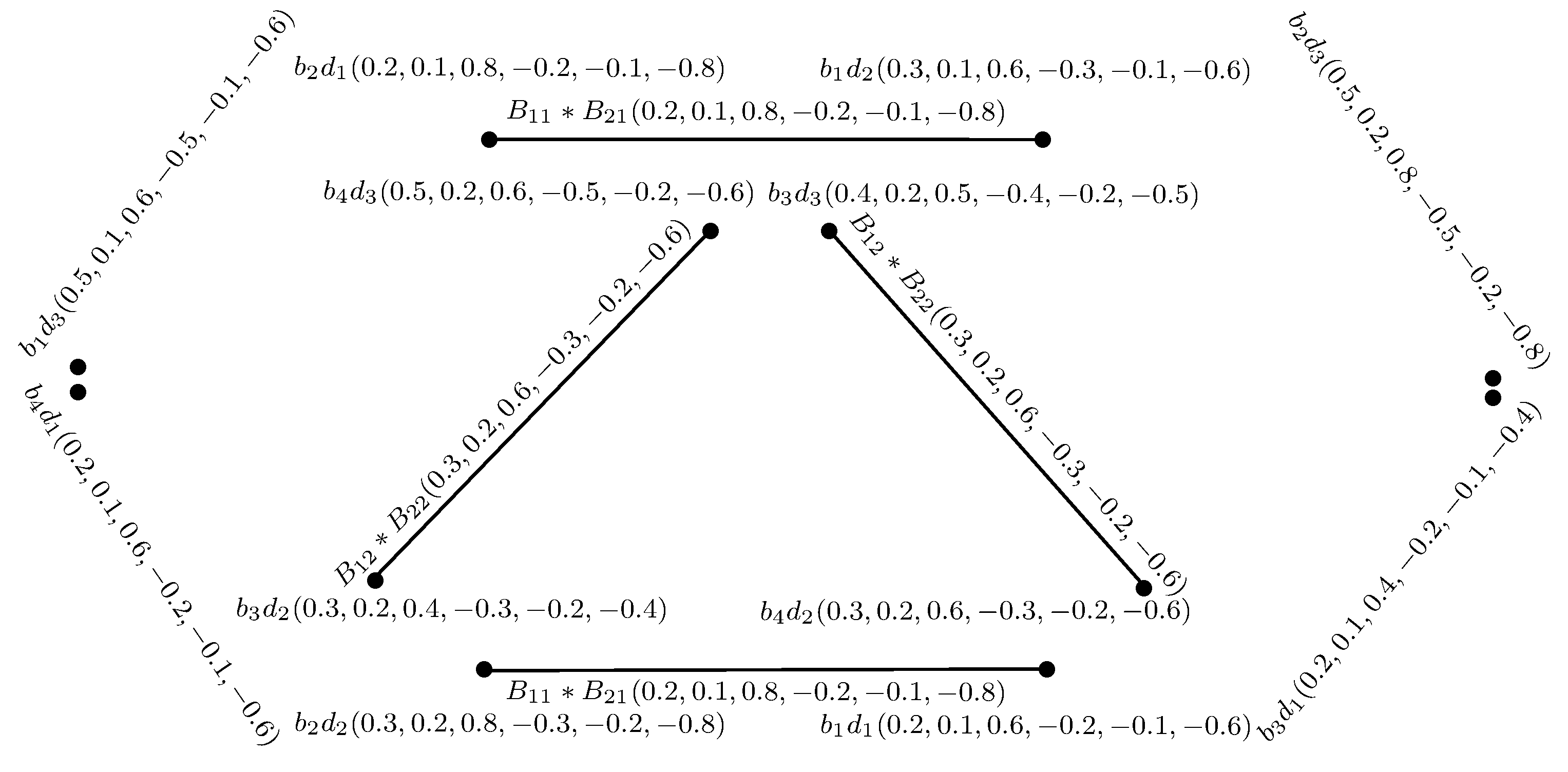1. Introduction
Fuzzy graphs are mathematical models for dealing with combinatorial problems in different domains, including operations research, optimization, computer science and engineering. In 1965, Zadeh [
1] proposed fuzzy set theory to deal with uncertainty in abundant meticulous real-life phenomena. Fuzzy set theory is affluently applicable in real-time systems consisting of information with different levels of precision. Subsequently, Atanassov [
2] introduced the idea of intuitionistic fuzzy sets in 1986. However, for many real-life phenomena, it is necessary to deal with the implicit counter property of a particular event. Zhang [
3] initiated the concept of bipolar fuzzy sets in 1994. Evidently bipolar fuzzy sets and intuitionistic fuzzy sets seem to be similar, but they are completely different sets. Bipolar fuzzy sets have large number of applications in image processing and spatial reasoning. Bipolar fuzzy sets are more practical, advantageous and applicable in real-life phenomena. However, both bipolar fuzzy sets and intuitionistic fuzzy sets cope with incomplete information, because they do not consider indeterminate or inconsistent information that clearly appears in many systems of different fields, including belief systems and decision-support systems. Smarandache [
4] introduced neutrosophic sets as a generalization of fuzzy sets and intuitionistic fuzzy sets. A neutrosophic set has three constituents: truth membership, indeterminacy membership and falsity membership, for which each membership value is a real standard or non-standard subset of the unit interval
. In real-life problems, neutrosophic sets can be applied more appropriately by using the single-valued neutrosophic sets defined by Smarandache [
4] and Wang et al. [
5]. Deli et al. [
6] considered bipolar neutrosophic sets as a generalization of bipolar fuzzy sets. They also studied some operations and applications in decision-making problems.
On the basis of Zadeh’s fuzzy relations [
7], Kauffman defined fuzzy graphs [
8]. In 1975, Rosenfeld [
9] discussed a fuzzy analogue of different graph-theoretic ideas. Later on, Bhattacharya [
10] gave some remarks on fuzzy graphs in 1987. Akram [
11] first introduced the notion of bipolar fuzzy graphs. In 2011, Dinesh and Ramakrishnan [
12] studied fuzzy graph structures and discussed their properties. In 2016, Akram and Akmal [
13] proposed the concept of bipolar fuzzy graph structures. Certain concepts on graphs have been discussed in [
14,
15,
16,
17,
18,
19]. Ye [
20,
21,
22] considered several applications of single-valued neutrosophic sets. Inthis research paper, we present certain concepts of bipolar single-valued neutrosophic graph structures (BSVNGSs). We introduce some operations on BSVNGSs and elaborate on these with examples. Moreover, we investigate some relevant and remarkable properties of these operators.
We have used standard definitions and terminologies in this paper. For other notations, terminologies and applications not mentioned in the paper, the readers are referred to [
23,
24,
25,
26,
27,
28,
29].
2. Bipolar Single-Valued Neutrosophic Graph Structures
Definition 1. [4] A neutrosophic set N on a non-empty set V is an object of the formwhere and there is no restriction on the sum of , and for all . Definition 2. [5] A single-valued neutrosophic set N on a non-empty set V is an object of the formwhere and the sum of , and is confined between 0 and 3 for all . Definition 3. [23] A BSVN set on a non-empty set V is an object of the formwhere and . The positive values and denote the truth, indeterminacy and falsity membership values of an element , whereas negative values and indicate the implicit counter property of truth, indeterminacy and falsity membership values of an element . Definition 4. [23] A BSVN graph on a non-empty set V is a pair , where B is a BSVN set on V and R is a BSVN relation in V such that We now define the BSVNGS.
Definition 5. [30] A BSVNGS of a graph structure = is denoted by = , where is a BSVN set on the set V and are the BSVN sets on such thatfor all Note that , for all , and represents an edge between two vertices b and d. In this paper we use in place of . Example 1. Consider a graph structure such that , , , and . Let B be a BSVN set on V given in Table 1 and , and be BSVN sets on , and , respectively, given in Table 2. By direct calculations, it is easy to show that = is a BSVNGS. This BSVNGS is shown in Figure 1. Generated with LaTeXDraw 2.0.8 on Saturday March 11 20:30:24 PKT 2017. Definition 6. A BSVNGS = is called a -cycle if , is a -cycle.
Example 2. Consider a BSVNGS = as shown in Figure 2. is a -cycle, as , is a -cycle, that is, ----.
Definition 7. A BSVNGS = is a BSVN fuzzy -cycle (for any k) if is a -cycle and no unique -edge exists in , such that , , , , or
Example 3. Consider a BSVNGS = as depicted in Figure 3. , , , , or
Definition 8. A sequence of vertices (distinct) in a BSVNGS = is called a -path, that is, , such that is a BSVN -edge, for all .
Example 4. Consider a BSVNGS = as represented in Figure 4. In this BSVNGS, the sequence of distinct vertices is a BSVN -path.
Definition 9. Let = be a BSVNGS. The positive truth strength , positive falsity strength , and positive indeterminacy strength of a -path, = , are defined as Similarly, the negative truth strength , negative falsity strength , and negative indeterminacy strength of a -path are defined as Example 5. Consider a BSVNGS = as shown in Figure 5. In this BSVNGS, there is a -path, that is, = ,. Thus, = , = , = , = , = and = .
Definition 10. Let = be a BSVNGS. Then
The -positive strength of connectedness of truth between two nodes b and d is defined by = , such that = for and = = .
The -positive strength of connectedness of indeterminacy between two nodes b and d is defined by = , such that = for and = = .
The -positive strength of connectedness of falsity between two nodes b and d is defined by = , such that = for and = = .
The -negative strength of connectedness of truth between two nodes b and d is defined by = , such that = for and = = .
The -negative strength of connectedness of indeterminacy between two nodes b and d is defined by = , such that = for and = = .
The -negative strength of connectedness of falsity between two nodes b and d is defined by = , such that = for and = = .
Definition 11. Let = be a BSVNGS and “b” be a node in . Let be a BSVN subgraph structure of induced by such that Then b is a BSVN fuzzy cut-vertex if , , , , and , for some . Note that vertex b is a BSVN fuzzy cut-vertex if , it is a BSVN fuzzy cut-vertex if , and it is a BSVN fuzzy cut-vertex if . Moreover, vertex b is a BSVN fuzzy cut-vertex if , it is a BSVN fuzzy cut-vertex if and it is a BSVN fuzzy cut-vertex if .
Example 6. Consider a BSVNGS = as depicted in Figure 6, and let = be a BSVN subgraph structure of the BSVNGS , which is obtained through deletion of vertex . The vertex is a BSVN fuzzy cut-vertex and a BSVN fuzzy cut-vertex, because , , , , , . , and .
Definition 12. Suppose = is a BSVNGS and is a -edge. Let be a BSVN fuzzy spanning subgraph structure of , such that Then is a BSVN fuzzy -bridge if , , , , and , for some . Note that is a BSVN fuzzy bridge if , it is a BSVN fuzzy bridge if and it is a BSVN fuzzy bridge if . Moreover, is a BSVN fuzzy bridge if , it is a BSVN fuzzy bridge if and it is a BSVN fuzzy bridge if .
Example 7. Consider a BSVNGS = as depicted in Figure 6 and = , a BSVN spanning subgraph structure of the BSVNGS obtained by deleting-edge and that is shown in Figure 7. This edge is a BSVN fuzzy -bridge, as = , = 0.4, = , = , = , , = = , = = , and = =
Definition 13. A BSVNGS = is a -tree if is a -tree. Alternatively, is a -tree if has a subgraph induced by that forms a tree.
Example 8. Consider the BSVNGS = as depicted in Figure 8. This BSVNGS = is a -tree, as is a -tree.
Definition 14. A BSVNGS = is a BSVN fuzzy -tree if has a BSVN fuzzy spanning subgraph structure = such that for all -edges, not in :
is a -tree.
, , , , , and .
In particular, is a BSVN fuzzy tree if , it is a BSVN fuzzy tree if , and it is a BSVN fuzzy tree if . Moreover, is a BSVN fuzzy tree if , it is a BSVN fuzzy tree if , and it is a BSVN fuzzy tree if .
Example 9. Consider the BSVNGS = as depicted in Figure 9. It is -tree, rather than a -tree. However, it is a BSVN fuzzy -tree, because it has a BSVN fuzzy spanning subgraph as a -tree, which is obtained through the deletion of the -edge from . Moreover, , , , , , , and
Now we define the operations on BSVNGSs.
Definition 15. Let = and = be two BSVNGSs. The Cartesian product of and , denoted byis defined as - (i)
- (ii)
for all ,
- (iii)
- (iv)
for all ,
- (v)
- (vi)
for all , .
Example 10. Consider = and = as BSVNGSs of GSs = and = , respectively, as depicted in Figure 10, where , , , and . The Cartesian product of and , defined as = , is depicted in Figure 11 and Figure 12. Theorem 1. The Cartesian product = of two BSVNSGSs of GSs and is a BSVNGS of .
Proof. Consider two cases:
- Case 1.
For
,
,
for
- Case 2.
For
,
,
for
Both cases hold for all . This completes the proof. ☐
Definition 16. Let = and = be two BSVNGSs. The cross product of and , denoted byis defined as - (i)
- (ii)
for all , and
- (iii)
- (iv)
for all ,
Example 11. The cross product of BSVNGSs and shown in Figure 10 is defined as = and is depicted in Figure 13. Theorem 2. The cross product = of two BSVNSGSs of GSs and is a BSVNGS of .
Proof. For
,
,
where
and
. ☐
Definition 17. Let = and = be two BSVNGSs. The composition of and , denoted byis defined as - (i)
- (ii)
for all ,
- (iii)
- (iv)
for all ,
- (v)
- (vi)
for all , and
- (vii)
- (viii)
for all , such that .
Example 12. The composition of BSVNGSs and shown in Figure 10 is defined as = and is depicted in Figure 14 and Figure 15. Theorem 3. The composition = of two BSVNGSs of GSs and is a BSVNGS of .
Proof. Consider three cases:
- Case 1.
For
,
,
for
- Case 2.
For
,
,
for
- Case 3.
For
,
such that
,
where
.
All cases are satisfied for all . ☐
